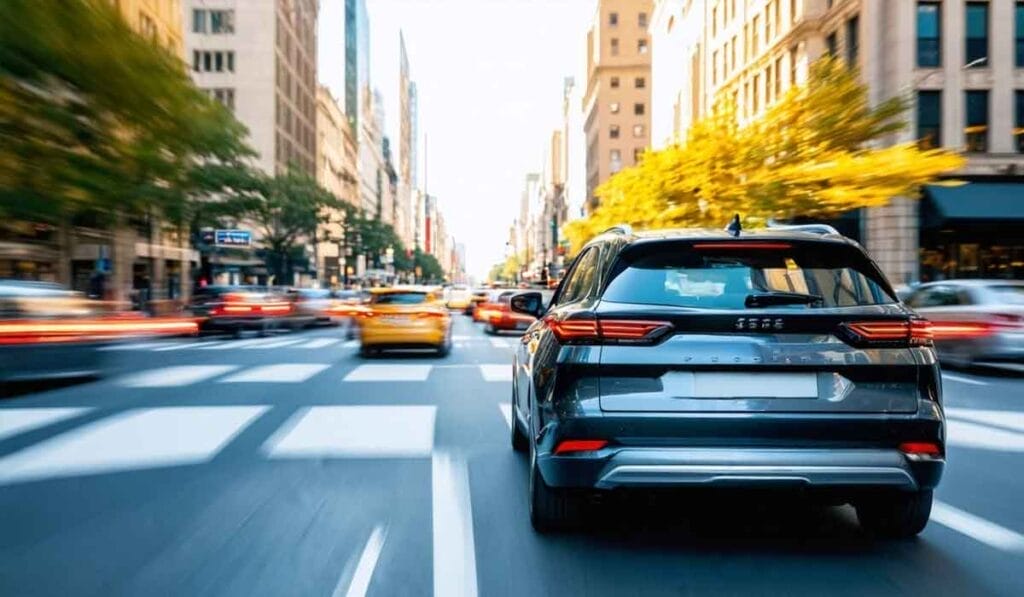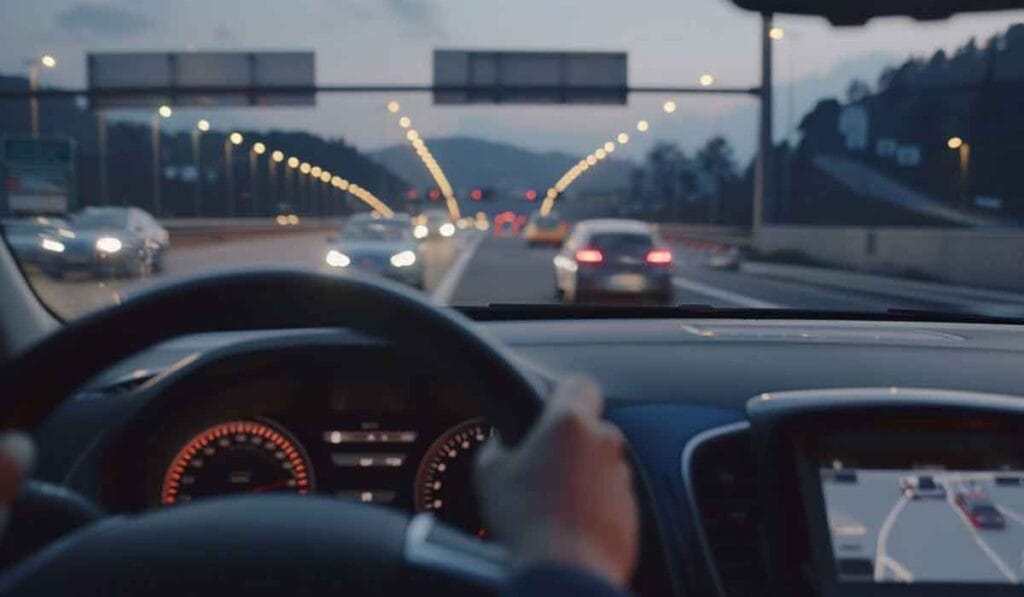Discover the Truth: Do Car Safety Features Lessen Accidents?
You’re driving every day, wondering if your car is safe enough.
A study by the Insurance Institute for Highway Safety shows that modern safety features can reduce crashes.
This article will show you how things like automatic braking y blind spot warnings make a difference.
Conclusiones clave
- Modern car safety features like airbags, automatic emergency braking (AEB), and blind spot detection can really help prevent accidents. The National Highway Traffic Safety Administration says airbags have been a must in cars since the 1990s. Forbes Advisor and experts from Carnegie Mellon University point out that these features, especially airbags, have saved tens of thousands of lives.
- Advanced technologies such as AEB reduce rear-end crashes by up to 50% by automatically stopping the car before an accident happens. Blind spot detection also makes changing lanes safer by warning drivers about cars they can’t see.
- Investing in car safety features not only saves lives but also comes with financial benefits like lower insurance rates and higher resale values for your vehicle. Plus, using these technologies leads to better driving habits over time.
Overview of Advanced Car Safety Features

Cars now have amazing tools to keep you safe on the road. These features, like airbags and automatic braking, work hard to prevent crashes before they happen.
Airbags
Airbags are a crucial car safety feature designed to protect you in case of a collision.
Think of airbags as your vehicle’s built-in defense mechanism, deploying in milliseconds during an accident to create a buffer between you and the hard surfaces of your car.
They work together with seat belts to reduce injuries, especially serious head and chest injuries.
Frontal airbags have been standard in all new cars since the late 1990s, thanks to regulations by the National Highway Traffic Safety Administration (NHTSA).
Side airbags, protecting your head and chest from side-impact collisions, have also become common.
Airbag technology has evolved significantly over the years.
Today’s vehicles may include advanced systems like knee airbags that help prevent leg injuries and curtain airbags that deploy from above door frames to protect occupants’ heads in rollovers or side impacts.
These innovations show how seriously manufacturers take road safety. Safety experts at Forbes Advisor and Carnegie Mellon University highlight the effectiveness of airbag systems in saving lives—it’s estimated they’ve saved tens of thousands since their introduction.
Seat belts save lives but combined with air bags, they form a vital duo that significantly reduces crash fatalities.
Automatic Emergency Braking

Automatic Emergency Braking (AEB) is a lifesaver on the road, cutting down your chances of a crash.
Vehicles equipped with AEB sense potential collisions before you might even notice them.
They automatically apply the brakes if they detect an imminent threat, reducing accident severity or avoiding it altogether.
This technology combines several sophisticated systems like sensors and cameras to keep an eye out for danger ahead.
Your car’s AEB works tirelessly behind the scenes, whether you’re navigating busy city streets or cruising down the highway.
It’s like having an extra set of eyes focused solely on preventing crashes.
And, in cases where accidents are unavoidable, AEB plays a critical role in lessening impact force, thereby protecting you and your passengers more effectively.
Implementing features like automatic emergency braking in your vehicle not only boosts your safety but also enhances overall driving confidence.
Embracing this advanced driver assistance system empowers you to tackle roads more securely, knowing you have smart technology ready to intervene during those unexpected moments.
Blind Spot Detection

Blind spot detection is a lifesaver on busy roads, alerting you to vehicles hiding in those hard-to-see areas.
Your car’s mirrors can’t catch everything, especially when another vehicle sneaks into your blind spot.
With this advanced driver assistance system, sensors monitor the sides of your car.
Ellos trigger a warning—usually a light or beep—if there’s something in the way when you’re trying to change lanes.
This means fewer surprises and safer lane changes.
Think of it as having an extra set of eyes that watches over those tricky spots around your vehicle.
Whether you’re zipping down the highway or navigating crowded city streets, blind-spot monitoring helps avoid sideswipes and merges gone wrong by catching what you might miss.
It’s not just about avoiding accidents; it’s about driving with confidence, knowing you have technology on board that keeps watch for danger lurking just out of sight.
Impact of Safety Features on Accident Rates
Advanced car safety features play a massive role in cutting down the number of road mishaps we hear about every day.
They not only protect us during accidents but also help in avoiding them altogether.
Reduction in Collision Incidents

Car safety features significantly reduce the number of accidents on our roads.
Take automatic emergency braking (AEB) systems, for instance—these marvels of modern technology detect potential collisions before they happen and apply the brakes if you don’t respond in time.
Statistics show that AEB can lower rear-end crashes by as much as 50%.
Similarly, lane-keeping assist helps keep your vehicle centered in its lane, greatly reducing the risk of side-swipe accidents caused by drifting.
Safety features like blind spot detection y rear cross-traffic alert have changed the game.
Blind spot detection alerts you when another vehicle enters your blind spot, making lane changes safer.
Rear cross-traffic alert is equally important; it warns you of approaching vehicles when backing out of a parking space or driveway—crucial for preventing those pesky fender benders.
These tools may seem simple but play a huge role in avoiding accidents each day.
Together with forward collision warnings and electronic stability control (ESC), these innovations have made driving less daunting and more secure than ever before.
Choosing a car equipped with these technologies could mean the difference between being involved in an accident or avoiding one altogether.
Make sure to prioritize such features when selecting your next vehicle—they are not just amenities but necessities for carretera segura today.
Influence on Driver Behavior

Advanced car safety features like lane-keeping assist, blind-spot warning systems, y adaptive cruise control have a big impact on how you drive.
These technologies are designed to alert you about potential hazards and help keep you safe on the road.
With these tools at your disposal, you might find yourself becoming more aware of your surroundings.
They encourage safer driving habits by reminding you to stay in your lane, watch for pedestrians, and maintain a safe distance from other vehicles.
Automatic emergency braking and forward-collision warning systems play critical roles too.
Imagine driving down a busy highway; these systems can detect when a collision is likely and either alert you or apply the brakes automatically.
This not only helps prevent accidents but also teaches drivers to be cautious and react quickly in dangerous situations.
As these features become more common in vehicles, drivers learn to trust technology as an aid in preventing vehicle collisions.
Using turn signals becomes second nature when lane change assists chime in with reminders if you forget.
Backup cameras make reversing safer by showing hidden obstacles, thus reducing accidents even more.
These advancements work together to create safer roads for everyone by improving driver behavior over time – making attention and quick reactions part of every journey.
Considerations When Choosing Safety Features

Deciding on safety features in a car isn’t just about picking the latest tech. It’s about weighing the perks against the price and thinking how well they match your driving style.
Cost vs. Benefit Analysis
Understanding the cost versus benefit of car safety features requires a deep dive into how these technologies impact both your wallet and your well-being on the road.
Let’s dissect this, keeping in mind your goal to ensure safety without breaking the bank.
| Car Safety Feature | Cost | Benefit |
|---|---|---|
| Airbags | High initial cost, maintenance can add up | Significant reduction in fatalities and severe injuries in the event of a collision |
| Automatic Emergency Braking (AEB) | Moderate to high cost, depending on the vehicle | Greatly decreases the chance and severity of a front-to-rear crash |
| Blind Spot Detection | Varies, often bundled with other safety packages | Improves lane-changing decisions, reducing the risk of side collisions |
| Overall Investment in Safety Features | Can be significant, especially for high-end models | Peace of mind, potential insurance savings, and better vehicle resale value |
Investing in these features might seem like a hefty upfront cost.
But, it’s crucial to weigh that against the potential for saving lives, reducing injuries, and even saving money in the long run through lower insurance premiums and fewer accident-related expenses.
Enhanced safety features can also boost your car’s resale value, making it a smart long-term investment.
Embrace the advancements in vehicle safety technology. While the initial price tag can be high, the benefits—ranging from peace of mind to financial savings down the road—are compelling.
Your safety, and that of your passengers, is paramount.
Investing in these features not only protects you but also contributes to safer roads for everyone.
Compatibility with Driving Habits
Choosing the right safety features for your car means thinking about how you drive.
If you often find yourself on crowded city streets, pedestrian detection and automatic braking systems can be lifesavers.
They react quickly if someone steps in front of your car, much faster than a human might.
For highway drivers, lane keeping assist and lane departure warnings keep you safely in your lane when those long trips make it hard to stay focused.
For folks living in snowy or rainy climates, traction control and antilock brakes are must-haves.
These systems help maintain control during slippery conditions, making each journey safer.
Using rear-view cameras makes parking easier and safer by showing what’s behind you, perfect for both newbies and experienced drivers in tight spots.
Lastly, let’s talk about blind spots – they’re tricky for everyone.
Blind spot detection lights up when there’s a car hiding where you can’t see it, reducing chances of sideswipes while changing lanes.
Matching these technologies with your daily driving challenges ensures not just a safer ride but peace of mind every time you buckle up.
Each feature acts as an extra set of eyes on the road, tailored to complement your unique driving habits perfectly.
Conclusión

Safety features in cars, like airbags and emergency stopping systems, really do make a difference.
Ellos cut down on crashes y Salvar vidas. It’s like having an extra set of eyes that never blink, always watching out for danger.
But remember – it’s not just about the tech in your car; how you drive plays a big part too.
Smart choices behind the wheel matter just as much as what’s built into your vehicle.
Keep this mind as you hit the road – every added safety option is a step toward fewer accidents and safer journeys for everyone.
preguntas frecuentes
1. What are some of the car safety features designed to lessen auto accidents?
Car safety features include advanced driver assistance systems, crash avoidance technologies like forward collision warning systems and emergency braking systems, stability-control system (DSTC), lane-departure warning (LDW), lane-keeping assist (LKA) and rearview video systems.
2. How do seatbelts contribute to reducing car accidents?
Seatbelts, such as three-point seat belts combining a lap belt and shoulder harness, play a crucial role in automotive safety by securing passengers during sudden stops or collisions thus lessening potential injuries from car accidents.
3. Can child seats offer protection during vehicle crashes?
Absolutely! Child safety seats provide specific protection for young passengers in case of a vehicle crash by securely holding them in place to minimize movement and impact.
4. Does the antilock brake system help prevent car accidents?
Yes! The antilock brake system helps maintain control over the accelerator pedal especially on slippery surfaces, which can indeed prevent many potential car accidents.
5. Do modern cars come with accident avoidance systems?
Indeed they do! Modern vehicles often feature accident avoidance systems including cross-traffic alerts, lane centering assist and automatic brakes that all work together towards preventing car accidents.
6. How does distracted driving relate to these safety features?
While these technological advancements aim at enhancing road security; it’s important to remember that no amount of technology can fully compensate for safe driving habits – avoiding distractions is key to maximizing their effectiveness against auto incidents.

